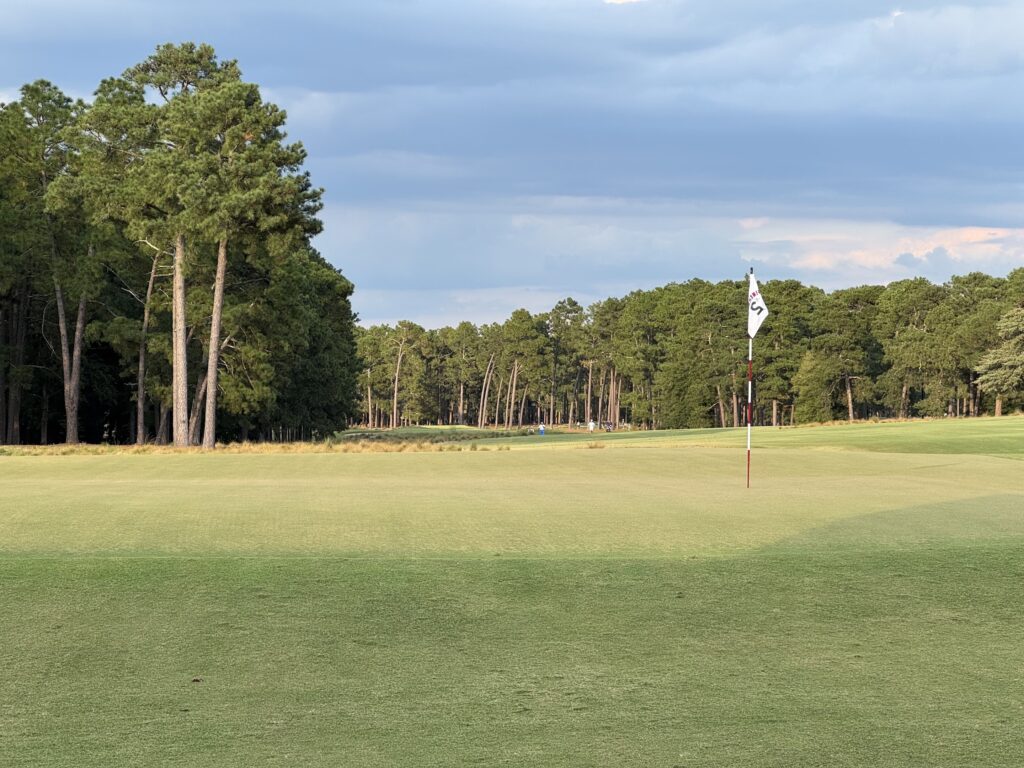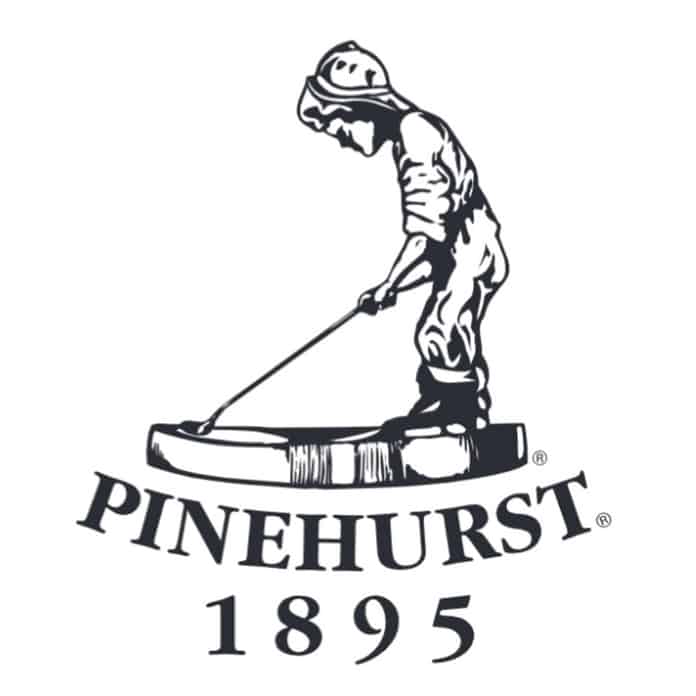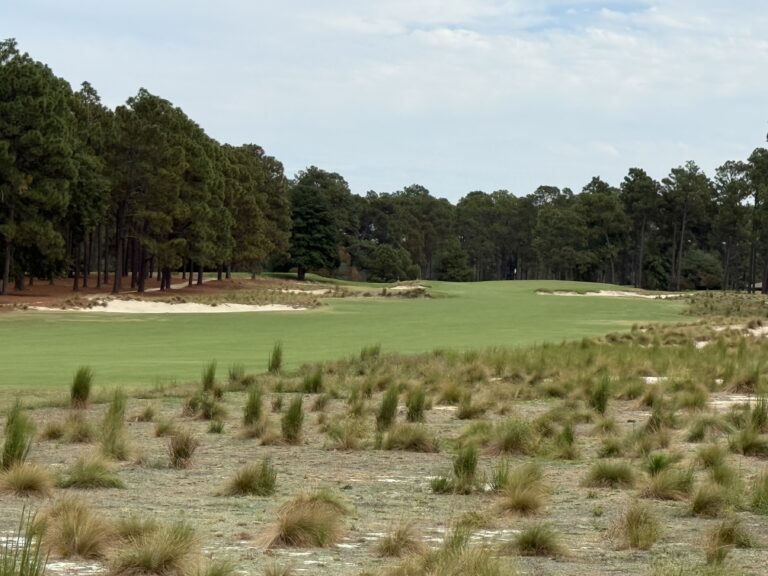Pinehurst No. 2 opened as an 18-hole course in 1907, the work of Donald Ross on the resort’s central Sandhills acreage; from that point he treated No. 2 as a long-term project, repeatedly revising it through the 1930s and into the 1940s. Contemporary reporting and later summaries agree that Ross continued “fine-tuning” the course for decades after 1907, with sources placing his last major efforts in the mid-1930s and ongoing adjustments into the 1940s (with 1946 often cited as a practical endpoint).
Ross’s clearest stated intent for No. 2 comes from his own remark, now posted by the first tee and repeated in championship literature: he believed No. 2 to be “the fairest test of championship golf [he] ever designed,” a standard he pursued on this particular property by emphasizing precision into perched, shedding greens rather than hazard-heavy heroics. This statement is preserved in tournament fact sheets and historical features produced around USGA championships on No. 2.
Two agronomic milestones show how Ross evolved No. 2 on site. First, Pinehurst’s greens were originally oiled sand; Ross and the club trialed grass on select No. 2 greens during 1934 and then undertook a full conversion to Bermuda in May 1935, recontouring and enlarging putting surfaces during the changeover. This conversion is well documented in period resort accounts and recent historical work. Second, 1935 also brought a routing adjustment: Ross discarded the former No. 2 ninth and tenth (on land later associated with No. 4) and added the present fourth and fifth to the card, bringing today’s core corridors into being.
After Ross’s era, preparation for modern championships introduced phases not of his hand. Robert Trent Jones Sr. remodeled the course in 1974, a period widely associated with the installation of thick Bermuda rough flanking narrowed fairways—conditions that defined televised championships at Pinehurst late in the 20th century. Rees Jones then renovated in the lead-up to the 1999 U.S. Open and again modified bunkering before the 2005 Open; his firm also added back tees for the 2005 championship.
The most consequential late-modern phase was the 2010–11 restoration by Bill Coore & Ben Crenshaw, working with Pinehurst’s Bob Farren and historical aerials (notably a December 1943 image) to recapture Ross-era fairway widths, bunker placements and the sand-and-wiregrass native character around the playing surfaces. Irrigated acreage was reduced from ~85 to ~45 acres and sprinkler heads from roughly 1,100 to about 450; winter overseeding ceased to promote firm ground.
Immediately after staging the back-to-back U.S. Opens in 2014, the resort converted No. 2’s greens from bentgrass to Champion ultradwarf Bermuda to better fit the Sandhills climate and resort traffic; 2024 thus became the first U.S. Open contested on ultradwarf Bermuda putting surfaces at No. 2.
Unique Design Characteristics (hole-specific)
The course’s identity remains anchored by green complexes Ross built up from the native sand, surfaces that convexly shed imprecise approaches into closely mown surrounds. The USGA has explicitly tied No. 2’s playing character to these “convex plateaus,” noting how the restoration re-activated width so that angle into each green matters as much as raw distance.
On the par-4 2nd, the angled, elevated target accepts approaches best from the far-left portion of the fairway; misses slide from the putting surface into chipping hollows. Contemporary hole-by-hole descriptions and analytical features repeatedly flag No. 2 as an exemplar of Ross’s perched-target problem at Pinehurst.
The par-5 5th and par-3 6th constitute a notorious mid-outward pair. The 5th finishes at a green that rejects from its front and flanks, while the 6th’s short grass before the surface acts as a built-in repellent; coverage for recent championships emphasizes how slightly short or slightly offline is punished by the contours rather than by rough.
The par-4 11th shows how Ross created demand on flatter ground: the restored corridor is visually ample, but the approach is exacting to a sloped, elevated green where the safe miss and reception vary with hole location. The long par-4 14th, repeatedly highlighted in course analyses, is a late-round examination keyed to its tilted green and the strategic premium of driving position to open or close portions of the surface.
Finally, the par-5 16th uniquely brings water into view while still finishing at a green less perched than most, showcasing Ross’s variance within a consistent theme; modern essays and archival imagery call out the front-right hazard patterning and the way run-up contours, not rough, create the difficulty.
As to the clearest surviving examples of Ross’s ideas at No. 2 today, the 2nd remains the touchstone because its strategic demand is inseparable from the restored fairway width and the green’s crowned geometry; the 5th illustrates his use of frontal contours to filter weak approaches; and the 14th demonstrates how a rotely straight corridor still yields multivariate play because the green’s axis and fall-offs dictate ideal angles. These selections align with USGA features, recent championship guides and long-form analyses published after the restoration.
Historical Significance
Within Ross’s corpus, No. 2 matters first for chronology: it began as an early-century layout and then, crucially, became his laboratory at his home base, where the 1935 grass-green conversion and green recontouring set the model for how he wanted the property to test elite play—through exacting approach and recovery rather than penal rough. The 1935 remodeling has been singled out as the last major Ross improvement and the moment the present 4th and 5th joined the routing.
No. 2’s championship run confirms that status. It hosted the 1936 PGA Championship (Denny Shute), the 1951 Ryder Cup (U.S. captained by Sam Snead) and, in the modern era, the U.S. Opens of 1999 (Payne Stewart), 2005 (Michael Campbell), 2014 (Martin Kaymer) and 2024 (DeChambeau), with the USGA naming Pinehurst its first U.S. Open “anchor site” and fixing additional Opens on No. 2 for 2029, 2035, 2041 and 2047.
Critical reputational assessments place No. 2 near the top of American courses: GOLF’s 2024–25 U.S. Top-100 lists it at No. 13 and also ranks it No. 2 among the nation’s public-access courses; these placements reflect the course specifically in its restored, sand-native state.
Current Condition / Integrity
Routing and hole corridors remain fundamentally Ross, with the restoration explicitly guided by 1940s aerials to re-establish the turf footprint, fairway width (often 40–50+ yards), diagonal hazard intrusion and green-edge short-grass fall-offs that activate recovery options. Pinehurst’s and the USGA’s documentation detail how machine rough was removed in favor of native sandscapes and wiregrass, not as ornament but to return the ball-lie variability Ross exploited.
In infrastructural terms, irrigation was cut dramatically (from ~1,100 heads to ~450; irrigated acres from ~85 to ~45), and winter overseeding ceased—changes that support the firm playing qualities these greens require. Bunkers were reshaped in plan and edge profile to match Ross-era photographs, and several green pads (e.g., 15 and 17) were modestly expanded to recover lost hole locations without altering their essential perched character.
The putting surfaces themselves are not Ross’s original soils: they were repeatedly re-grassed in the 20th century and, most recently, converted to ultradwarf Bermuda immediately after the 2014 Opens to improve summertime performance and year-round consistency for heavy resort use. The USGA has noted that 2024 was the first U.S. Open contested on such surfaces at No. 2. In other words, the forms—the crowns, runoffs and axes—read as Ross because their perimeters and surrounding short grass were recaptured to historic lines, even as the grasses are contemporary.
What has been preserved today are the corridors, green locations and the strategic relationship between tee width and exacting targets that Ross refined here—particularly evident on holes like 2, 5 and 14. Alterations introduced during late-20th-century championship preparations (narrow rough lines, fairway constriction) have been intentionally reversed, while tree cover has been selectively reduced to reopen historic vistas and wind. Wiregrass and sand now fill the areas where mid-century rough once stood, an aesthetic and tactical reset consistent with Ross-era photography.
Events & Presenting Standard
No. 2 continues to function as a championship venue with minimal setup artifice: in 2014 and 2024 hole-by-hole guides emphasized how the course’s inherent defenses—false fronts at 5 and 6; angled, elevated surfaces at 2 and 14; exacting finish at 18—determine scoring. Those are the very elements Ross built on this ground, not tournament overlays.
Sources & Notes
1. “Pasture to Pinehurst: History of Pinehurst Sand Greens,” LINKS Magazine, detailing 1934 trials and May 1935 full conversion to Bermuda with green recontouring on No. 2.
2. “U.S. Open Fact Sheet (Women’s Open/Pinehurst No. 2): ‘I sincerely believe this course to be the fairest test…’,” GCSAA/USGA tournament materials quoting Ross’s statement at No. 2.
3. “A hole-by-hole look at Pinehurst No. 2,” Associated Press, June 2024, used for hole-specific features on 2, 5, 6, 11, 14, 18.
4. “Subtle and Strategic: The Pinehurst No. 2 Green Complexes,” USGA (Aug. 11, 2019), describing No. 2’s convex, shedding greens and their central role.
5. “Uncovering Pinehurst No. 2,” Bob Farren, USGA Green Section (2012), documenting restoration metrics: irrigated acres reduced ~85→45; sprinkler heads ~1,100→~450; end of overseeding.
6. “Irrigation Redesign to Conserve Water,” USGA Green Section (2013), citing the 1943 aerial as restoration evidence and confirming head reductions. archive.lib.msu.edu
7. “The Pinehurst No. 2 Restoration – A Hole-by-Hole Tour,” Pinehurst Resort (restoration notes: ~650 heads eliminated; 200,000 wiregrass plants; fairway lengthening; green-edge recapture on 15 & 17).
8. “No. 2: The Same But Different,” USGA Green Section (June 4, 2024), confirming post-2014 ultradwarf greens and native-area evolution.
9. “Pinehurst No. 2 reopens with Bermuda grass greens,” GolfPass (Sept. 12, 2014), corroborating the immediate post-2014 conversion to Champion ultradwarf.
10. “Pinehurst to convert No. 2 greens,” Golf Course Architecture (May 31, 2013), pre-announcement of ultradwarf conversions at Pinehurst.
11. Rees Jones, Inc. project page for Pinehurst No. 2 (notes on added back tees and championship preparation work ahead of 2005).
12. Reuters, “Hole-by-hole guide to Pinehurst No. 2” (June 5, 2014), for build year (1907), Ross fine-tuning through 1946, and Rees Jones 1999/2004 phases.
13. USGA press release naming Pinehurst No. 2 the first U.S. Open “Anchor Site,” fixing future Opens in 2029, 2035, 2041, 2047.
14. AP News capsule history of major events at Pinehurst No. 2 (1936 PGA, etc.).
15. Wikipedia, “1951 Ryder Cup,” confirming site (No. 2) and dates; cross-context with Pinehurst/Tufts Archives club features.
16. Carolinas PGA centennial article (PDF), noting Ross’s 1935 remodeling, the substitution of today’s 4th and 5th for the old 9th and 10th, and the grass-green conversion.
17. GOLF.com Top 100 (U.S.) 2024–25; Pinehurst No. 2 ranked 13th nationally and No. 2 among public-access courses.



